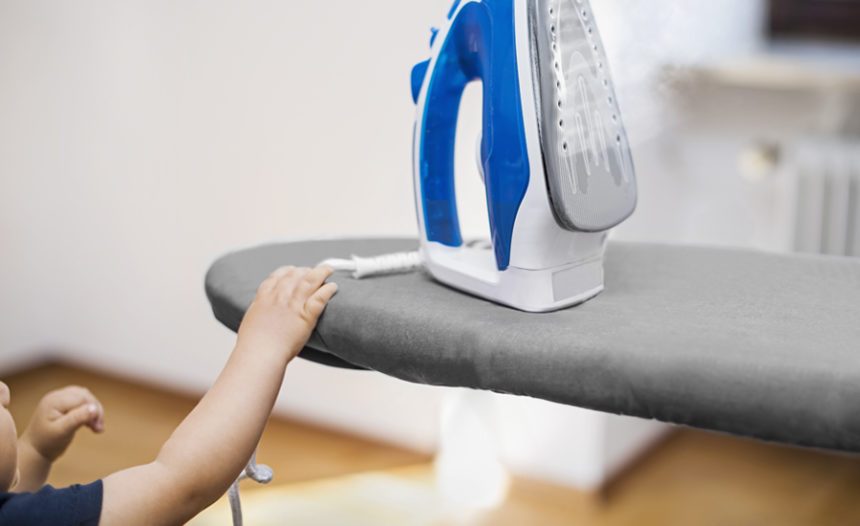Any parent can relate to the enormous, sometimes terrifying, responsibility of caring for a new baby. Infants require constant attention and care, and they rely on their caregivers to protect them from harm.
Suddenly, regular household items that once seemed harmless—window coverings, stuffed animals, laundry detergent—represent potential threats to your baby.
No parent wants to think about something terrible happening, but it’s important to know that injuries are the No. 1 cause of death among children, and babies under 1 year old are especially susceptible. Motor vehicle crashes are the biggest risk for injury, but suffocation, poisoning and drowning, all of which can happen at home, are also major threats.
When you’re aware of the risks, you can take steps to make your home much safer for your baby, says UNC Health pediatrician Edward Pickens, MD.
“Childproofing isn’t something you do just once. It’s something you do constantly because there are always things that change in your home and new situations arise,” he says. “And childproofing, while important, is not a substitute for supervision.”
Follow this room-by-room guide to help keep your baby safe at home.
Keep Baby Safe in the Bedroom
Make sure to follow all safe-sleep guidelines. Babies should sleep on their backs on a firm mattress, with nothing in their crib or bassinet—no bumper pads, stuffed animals, toys or blankets. Dress the baby in a sleep sack or warm pajamas as needed but avoid overheating. Remove hats, socks, hair ribbons or any other accessories before putting your baby to bed.
Never leave a baby unattended on a changing table or bed, even for a second.
Avoid sleeping with your baby. As tempting as it is to doze off together, it is dangerous for an adult to sleep with a baby. You could roll onto your baby without realizing it or the baby could fall out of the bed or off the couch.
Keep Baby Safe in the Bathroom
Never leave your child unattended in the bath, near the bath, or near any other standing water, including the toilet bowl. You can buy a safety lock to keep the toilet lid closed.
Turn the dial on your hot water tank so it can’t get hotter than a maximum of 120 degrees, to prevent scalding accidents.
Make sure your child can’t access medications, cleaning supplies, toiletries or appliances such as hair dryers. Put these items up high or behind a door with a safety lock (an automatic locking mechanism is best in case you forget to use the lock). Never leave an appliance plugged in near water or anywhere a child could pull the appliance down onto their head.
Keep Baby Safe in the Kitchen
Keep knives and other sharp objects out of children’s reach and behind safety locks.
Put a safety lock on cabinets containing household cleaners and plastic bags or store them high, out of a child’s reach. Laundry detergent and dish detergent pods can be attractive to babies and small children, and they are poisonous, even in very small amounts.
When cooking on the stove or using the oven, keep children out of the room or at a safe distance. Start teaching babies early that the stove is “Hot! Ow!”
Keep Baby Safe Throughout the Home
Keep small objects, including older children’s toys, out of baby’s reach and monitor any areas where the baby plays for coins, pills or other small items. Even gravel on shoes from outside can pose a risk. Any object that can fit in a toilet paper tube can fit into your child’s mouth and is a choking hazard; pills and small batteries create poisoning risks as well.
Use outlet covers or safety plugs on all electrical outlets within reach of your baby.
Anchor any tall or heavy furniture (bookshelves, TVs) to the wall to prevent toppling.
Install gates at the top and bottom of stairs to prevent falls.
Keep windows shut or open them from the top. Screens will not hold in the weight of a child.
Opt for cordless window blinds if possible. If you have cords, mount them to the wall or floor, or wrap them around wall brackets, so a child cannot put them around their neck.
Keep medication, chemicals and sharp objects put away and out of reach.
Where possible, cover sharp corners on furniture with removable pads.
Make sure you have smoke and carbon monoxide detectors on each level of your home and near where people sleep. Test them regularly to make sure they work.
No matter how gentle your pet, never leave animals unsupervised with a baby.
The American Academy of Pediatrics says that “the safest home for a child is one without a gun.” If you have firearms, store them unloaded and locked; lock up the ammunition in a separate location.
Finally, it’s important to remember that no home can be perfect, just as no parent is perfect. All you can do is take steps to make your home safer for your baby, and then stay vigilant. There’s no substitute for a watchful adult caregiver.
“When you have an infant or a toddler in your home who is on the move, your No. 1 priority has to be watching your child,” Dr. Pickens says.
If you have questions about your baby’s health and safety, ask your pediatrician. If you need a pediatrician, find one near you.

